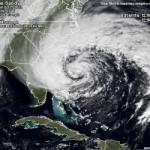
1600 km wide SuperStorm explains its spawning.
by Stephen Leahy
Hi, this is Sandy. People are calling me ‘Frankenstorm’, ‘Superstorm’ and even ‘Weatherbomb’.
I don’t mean to hurt anyone but the record moisture in the atmosphere and heat in the ocean has given me uncontrollable power. I probably will cause billions of dollars of damage in Washington, New York City Boston and other parts of the Northeast. And I will kill some people, I already have. At least 66 people died when I swept through Jamaica and Cuba a few days ago.
I am a force of nature — but you have to understand — this is not all my fault.
I was born a only a week Monday in the warm waters of the southwestern Caribbean sea as a cluster of thunderstorms — what you call a tropical depression, the first stage of a hurricane. One unusual thing about my birth was that it was so late in the hurricane-tropical storm season. But this is happening more and more often as the climate becomes warmer and large parts of the ocean stay warmer longer.
The air and sea are warmer because hundreds of millions of tonnes of carbon dioxide (CO2) from burning coal, oil, and natural gas are now in the atmosphere. You should know that CO2 is the planet’s heating blanket that has kept the planet warm by trapping some of the sun’s heat.
Those hundreds of millions of tonnes of CO2 you humans have put in the atmosphere means the CO2 blanket is thicker and capturing more heat from the sun. The amount of extra heat-energy being trapped is like exploding 400,000 Hiroshima atomic bombs per day 365 days per year.
Hundreds of millions of tonnes of extra CO2 mean the atmosphere traps extra heat-energy equivalent to exploding 400,000 Hiroshima atomic bombs per day 365 days per year.
Most of that extra heat has gone into the oceans, which is why land temperatures around the world have only risen 0.8 degree C (1.0F) on average. The oceans are getting warmer and warm water expands — that’s why pots boil over. That’s one reason why sea levels are rising. The other reason is melting glaciers and ice sheets.
Warmer air can also hold more moisture. Measurements show there is now 4 to 6 percent more water vapour (moisture) in the air making rainfalls heavier.
I was born in water 28C (80F) or better. To grow stronger I need warm water and lots of moisture in the air. There was plenty of both last week. By Monday evening my wind speeds were strong enough to be called a tropical storm. By Wednesday I was stronger still and named Hurricane Sandy, the 10th hurricane of 2012. There have been 19 tropical storms so far making this year tied for third busiest hurricane season in history.
Hurricanes live on warm water and moist air, which is why I lost strength going over the mountains and hills of Jamaica and Cuba. But the huge area of near-record warm waters from Florida all the way up the east coast gave me the energy to stay at hurricane strength and grow in size. In fact I’ve become so big I may be one of the biggest ever recorded.
This should not be a surprise. More heat trapped by the extra CO2 means more fuel for storms and more moisture for heavier rains and more flooding than in the past. Higher sea levels means storm surges will be more damaging.
More heat trapped by the extra CO2 means more fuel for storms and more moisture for heavier rains and more flooding than in the past.
Earth has re-distributed heat through hurricanes and typhoons for millions of years. Think of us as giant pressure-relief valves. With more heat in the atmosphere it shouldn’t be surprising that we’ve become bigger and more powerful.
I said I was a force of nature, many say an Act of God. But that’s no longer true, is it?
Check at this link for frequent Hurricane Sandy updates.
© Copyright 2012 Stephen Leahy, All rights Reserved. Written For: StraightGoods.ca
 Stephen Leahy is an environmental journalist based in Uxbridge, Ontario.
Stephen Leahy is an environmental journalist based in Uxbridge, Ontario.
Sorry, the comment form is closed at this time.